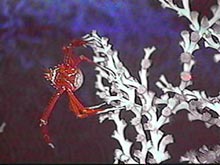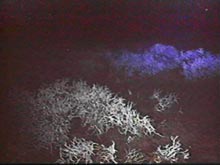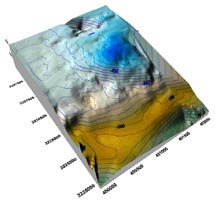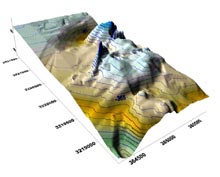
A Galatheid crab on a Lophelia pertusa coral. Many other organisms may live in the habitat created by the corals. Click image for larger view.
Educated Guesses
Julie Olson
University of Alabama
The rationale behind the selection of study sites, especially with a limited amount of time in the field and a rather poorly characterized system, begins to look a lot like educated guesswork. For better or worse, educated guesses are often the foundation of many preliminary studies. Before you start to panic, take comfort in the fact that many of the major achievements of science have resulted from a “hunch” or educated guess by a scientist.
Because relatively little is known about the distribution and abundance of deep-water corals in the Gulf of Mexico (GOM), many different types of information were used to create a short list of potential sites to visit. This information included visual observations, video footage from submersible and/or remotely operated vehicle dives, sonographs, and other indicators of the topography of the ocean floor (bathymetry). We also know that deep-water corals need certain habitat characteristics, such as high flow, for example, which often occurs on features such as shelf edges, pinnacles and boulders. Tolerance of environmental conditions like temperature or oxygen may also define the limits of distribution for a species. The more we learn about the corals, the greater our ability to predict where we might find them in unexplored areas of the ocean.
Is there any guarantee that we’ll find what we’re looking for? The deck is stacked as much as possible in our favor, but there are no absolutes in science. Because we based our site choices on previously collected information, it is likely that many of them will support coral communities. Much of the information used in the decision-making process came from studies of hydrocarbon seep communities (see 2002 Gulf of Mexico exploration). These expeditions examined the communities of unusual organisms that flourish in the vicinity of active hydrocarbon seeps. Our studies will focus on the biological assemblages that exist as a result of the seepage, but are not dependent upon active seepage.
VK906Bathymetry is a measure of the water depth relative to sea level. As a result, elevations or depressions of the sea floor can be readily detected. Here are samples of ocean floor bathymetry at two of the proposed sites (lease blocks VK826 (left) and VK906). Preliminary data from both sites suggest that corals are present. Differences in sea-floor elevation can be readily seen. Note that the elevation scales are different between the two images. Click image for larger view.
Much of the bottom of the GOM consists of muds, which are not suitable attachment substrates for many organisms, including corals. Solid carbonate deposits scattered throughout the GOM do provide a suitable substrate for attachment. These deposits were created in the past and are thought to result from the precipitation of authigenic carbonates. Authigenic means “formed in situ," and these carbonates were most likely formed through biological activity. Bacterial processes can both create acids to break down existing carbonates and create new carbonates. The presence of hydrocarbons via seepage created conditions of optimal resource availability for the bacteria, and many of the carbonate deposits are, therefore. located at sites of previous or current seepage. This is why we are interested in the results of previous expeditions to hydrocarbon seeps and in the topography of the ocean floor.

While some sites are likely to support only a couple of individual corals, others will have many corals spread over the available substrate. Click image for larger view.
Now it’s time to see how well we used previously collected data in our efforts to target locations likely to support deep-water corals. About half of our targeted sites have some information to suggest that corals exist; the remaining sites fall more into the educated guesswork category. Because so little is known about deep-water corals and their distribution, any information that we can add to our current knowledge will help determine the direction of future studies.























